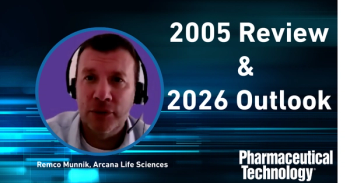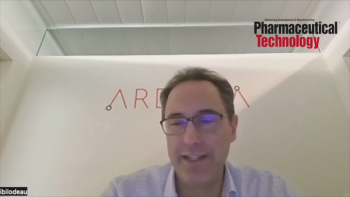
- Pharmaceutical Technology September 2025
- Volume 49
- Issue 7
- Pages: 30–33
Emerging Tools, Integrated Controls Impact Tech Transfer
Key Takeaways
- Rapid development of therapies requires a deep understanding of materials and processes to avoid costly setbacks in tech transfer.
- Integrated control architectures and plant-wide control systems enable data standardization, reducing risks and improving efficiency.
Experts from LGM Pharma and Rockwell Automation share their thoughts on what makes tech transfer effective, where processes could be improved, and why certain development and manufacturing decisions are so crucially important.
Successful technology transfer often calls upon the services of capable contract manufacturers, but the ways in which those manufacturers design and utilize their facilities, and structure their operations, can have myriad effects on the process. As always, time is of the essence, and in that regard, new and developing digital tools are helping to streamline efficiency.
Pharmaceutical Technology® posed a series of questions about the current state of tech transfer considerations to two industry experts: Deepak Thassu, PhD, senior vice president of R&D and Regulatory Submission at LGM Pharma, and Smriti Khera, head of Global Life Sciences Strategy and Marketing at Rockwell Automation. The following overview is broad in scope, but specific in addressing the distinct challenges of this crucial process.
Navigating the next generation
PharmTech: It seems like perhaps the biggest hurdle right now in executing an efficient tech transfer process is the fast pace of development of emerging therapies and next-generation modalities. What are the difficulties in establishing a solid enough knowledge base to keep up with these new formulations and forms of delivery?
Thassu (LGM Pharma): The rapid pace of development has not changed, but the complexity of formulations has increased significantly. Expectations for rapid development can create pressure on contract development and manufacturing organizations (CDMOs) to do more with less, but skipping the early knowledge-gathering phase can lead to costly setbacks. Anticipating shifts during scale-up requires a deep understanding of both materials and process. When critical quality attributes (CQAs) are tight, as they often are with complex or high-risk products, there’s little room for error. Without upfront identification of critical process parameters (CPPs) and material properties, troubleshooting becomes guesswork. An experienced CDMO can build the right foundation to support manufacturability, regulatory success, and seamless tech transfer.
PharmTech: What are the biggest operational challenges that integrated control architectures address—especially around tech transfer?
Khera (Rockwell Automation): One of the biggest challenges in tech transfer is the handoff of process knowledge from development to manufacturing. That knowledge often lives in static documents and spreadsheets, and the process of extracting it, reformatting it, and implementing it on production equipment is usually manual. These steps introduce risks that can affect everything from batch quality to compliance. Integrated control architectures help by providing a foundation for data standardization that includes a data structure where process data, control parameters, and equipment capabilities are mapped digitally from the start. This makes it possible to move from unstructured documentation to structured datasets that can be read directly by manufacturing systems. Instead of re-entering information for each new site, teams can work from a single digital source that links everything together—equipment specs, quality attributes, control ranges, and material definitions. This not only reduces the time it takes to complete a tech transfer but also lowers the risk of transcription errors and makes it easier to adapt the process to different sites or scales.
Partnering with CDMOs
PharmTech: The role of the CDMO is often crucial in tech transfer, but is a full-service, end-to-end CDMO not the best fit for smaller sponsor companies? In other words, if the expertise provided is too broad in scope, rather than concentrated in a few key areas, will the process be less effective?
Thassu (LGM): It’s a valid concern that relying too heavily on a full-service CDMO can reduce effectiveness, particularly if the CDMO lacks depth or coordination across its service areas. However, when the CDMO has proven experience and a successful track record, a broader scope leads to stronger alignment, fewer handoff risks, and faster progress. From the sponsor’s perspective, a comprehensive CDMO provides greater assurance that challenges won’t be passed downstream and that all teams are aligned on the shared goal of efficient, successful commercialization. An extensive partnership requires trust and open communication established early in development. An effective CDMO empowers the sponsor to make informed decisions, balancing scientific rigor with business considerations through transparent planning, clear rationale, and collaborative problem-solving.
PharmTech: What is the importance of open and transparent communication between partners?
Thassu (LGM): Open and transparent communication is essential to the success of tech transfer and to building a strong, collaborative partnership. Every client is different, with unique expectations around timing, budget, and decision-making. A flexible CDMO adapts to these needs, proactively shaping the scope of work to reflect cost constraints or deferring certain activities without compromising the bigger picture. At LGM Pharma, we maintain consistent touchpoints across R&D, project management, and business development to ensure alignment throughout the process. When communication is strong and expectations are clear, both partners can move forward with confidence to minimize risk, maximize efficiency, and build toward shared commercial success.
Relevance of plant-wide control
PharmTech: Can you explain the concept of plant-wide control and how it marks a shift from traditional unit-based operations in life sciences manufacturing? Why is this shift especially important for pharmaceutical manufacturing today?
Khera (Rockwell): Plant-wide control means managing an entire pharmaceutical production facility as one coordinated system rather than as a collection of independent units. In traditional setups, each step in the manufacturing process is usually isolated. This fragmented setup makes it difficult to coordinate operations, limits visibility into how each process impacts the next, and creates inefficiencies in troubleshooting, scaling, and maintaining quality. Today’s manufacturers need to be able to handle shorter product lifecycles, smaller batch sizes, and rapid product changeovers—and maintain strict compliance throughout. A plant-wide control system makes that possible. It allows teams to manage assets centrally, collect and analyze data more efficiently, and manage recipes in a structured, repeatable way against a holistic site strategy. By connecting quality, compliance, and production under a shared infrastructure, manufacturers can adapt more quickly to market demands, new production requirements, and regulatory changes without compromising product integrity.
PharmTech: Does batch size have a significant effect on the validity of the tech transfer process? How might that be a concern, or do most partnerships at the present time have effective safeguards in place to alleviate these concerns?
Thassu (LGM): Batch size plays a critical role in tech transfer because early-phase success with small-scale batches doesn't always translate to commercial scalability. Small batches can create a false sense of process robustness, especially when the underlying body of knowledge hasn’t been fully developed. If batch variability or out-of-spec issues arise, and the root cause isn’t well understood, the product may struggle throughout its lifecycle. These failures are often preventable with early technical engagement and a strong focus on scalability. Involving scientists early in the partnership, alongside business decision-makers, helps ensure process decisions aren’t driven solely by cost or speed, but also with scalability and long-term reliability in mind, setting the stage for a smooth and successful tech transfer.
PharmTech: What role does plant-wide control play in helping pharmaceutical companies scale from development to production more efficiently?
Khera (Rockwell): Scaling a process isn’t just about increasing batch volume. It usually involves translating lab-based methods into production-ready operations that use different equipment and operate under different constraints and conditions. The challenge is making sure that the intent and control strategy of the original process stay intact through every transition. Plant-wide control gives companies a better foundation for that scale-up. With a unified system, development teams can define process parameters in a structured format that considers future integration to manufacturing systems like manufacturing execution systems (MES) or distributed control systems (DCS). That makes it easier to reuse recipe elements and map them to site-specific equipment. Additionally, control automation that scales from lab to good manufacturing practice (GMP) production, further enables the reuse of automation code. For example, when a process designed in the lab needs to be run on a different size bioreactor or filtration unit, a plant-wide control system can provide a foundational data structure for those parameters to be incorporated into while accounting for equipment capabilities and scale-dependent factors. This cuts down on engineering time, reduces quality risk, and helps maintain consistency across sites. It also gives teams a set of operational parameters that can be used in building a digital twin of the process, which can be used to streamline testing and reduce change impact to operational equipment. Further, integrating with machine learning (ML) models for process optimization and scale up can further cut down on time needed and physical experiments needed to scale processes from R&D to GMP scale.
Timing and tools
PharmTech: How does this technology approach support emerging manufacturing models, such as continuous processing, personalized therapies, or modular plant architectures?
Khera (Rockwell): Each of these models pushes against the limitations of traditional batch-oriented systems. Continuous processing requires tightly synchronized operations with minimal downtime. Personalized therapies demand flexible systems that can switch between small-batch runs quickly. Modular architectures call for systems that can plug and play without major redesigns. A plant-wide control strategy creates the environment needed to support all three. For continuous manufacturing, it enables real-time communication across upstream and downstream processes, so the system can respond quickly to fluctuations or deviations. For personalized therapies, it allows rapid reconfiguration of recipes and equipment parameters without sacrificing traceability or quality. Modular plants benefit from having a common control backbone that makes it easier to add new production skids or units, even if they come from different vendors or are located in different geographies. In each case, the key is having a digital infrastructure that supports data standardization, recipe portability, and system interoperability. Plant-wide control does that by linking control strategies, manufacturing systems, and production data into one framework that can scale and adapt as the process evolves.
PharmTech: How about the timing of the process? In an environment in which competition to get the best therapies to patients as fast as possible is fierce, where are the pitfalls in making sure tech transfer doesn’t slow down development and innovation?
Thassu (LGM): Speed matters, but skipping foundational work to go faster often backfires. Tech transfer shouldn't begin at the point of manufacturing—it starts early in development, when you identify CQAs and CPPs, then define a design space to evaluate how the formulation performs under scale-up conditions. Development and innovation go hand in hand, but once you're in GMP manufacturing, there's no room for trial and error. We've seen real examples where seemingly small decisions, like tablet shape, created major delays later. Designing for manufacturability and robustness early in development is the best way to avoid rework and accelerate time-to-market.
PharmTech: How are digital tools helping tech transfer evolve? Specifically with regard to things like artificial intelligence (AI) and ML—how are these technologies being tested, harnessed, and deployed?
Thassu (LGM): Tech transfer will always rely on expert judgment, but digital tools are enhancing how we analyze data and make decisions. No one can make a decision without reviewing the data themselves. However, AI and ML can help identify patterns, flag risks, and simplify complex datasets to support that analysis. At LGM Pharma, we see value in applying these tools early to identify material variability, optimize process parameters, and reduce uncertainty during scale-up. The most effective use of today’s AI capabilities is not to replace experience, but to amplify it—streamlining development without compromising scientific rigor or product quality.
Final thoughts
PharmTech: What are the key considerations for transitioning from siloed or legacy control systems to an integrated, plant-wide control strategy?
Khera (Rockwell): The transition starts with understanding how process data [are] currently managed and identifying where handoffs and silos are slowing things down. In many facilities, site systems such as DCS, MES, enterprise resource planning (ERP), and quality systems may be running in parallel with equipment but not communicating with each other. There may be manual procedures to move data between these systems. Moving to plant-wide control requires building digital connections between those systems and aligning data models that can be shared across teams. Another key factor is defining standardized recipe structures early in the process. Using a framework like
PharmTech: What does the future hold? Are there trends on the horizon companies should be preparing for?
Thassu (LGM): With the rapid innovation and constantly changing regulatory requirements we’ve witnessed in recent years, what worked five years ago may no longer apply. New tools like physiologically based pharmacokinetic (PBPK) modeling are reshaping how developers approach formulation and process design, enabling a more bioavailable product before entering the clinic. Looking ahead, companies should prepare by embracing technology, fostering internal cross-functional expertise, and partnering with CDMOs that bring both technical depth and operational agility. The right partner is more than a manufacturer—they understand the financial, regulatory, and scientific dimensions of development. Flexibility is everything. As timelines shrink and expectations rise, a highly skilled and adaptable team becomes critical to maintaining speed without sacrificing quality.
About the author
Patrick Lavery is an Editor for Pharmaceutical Technology®.
Article details
Pharmaceutical Technology®
Vol. 49, No. 7
September 2025
Pages: 30–33
Citation
When referring to this article, please cite it as Lavery, P. Emerging Tools, Integrated Controls Impact Tech Transfer. Pharmaceutical Technology 2025 49 (7).
Articles in this issue
4 months ago
Keys to Navigating the Complex Drug Supply Chain4 months ago
Focusing on the Fundamentals of FormulationNewsletter
Get the essential updates shaping the future of pharma manufacturing and compliance—subscribe today to Pharmaceutical Technology and never miss a breakthrough.




